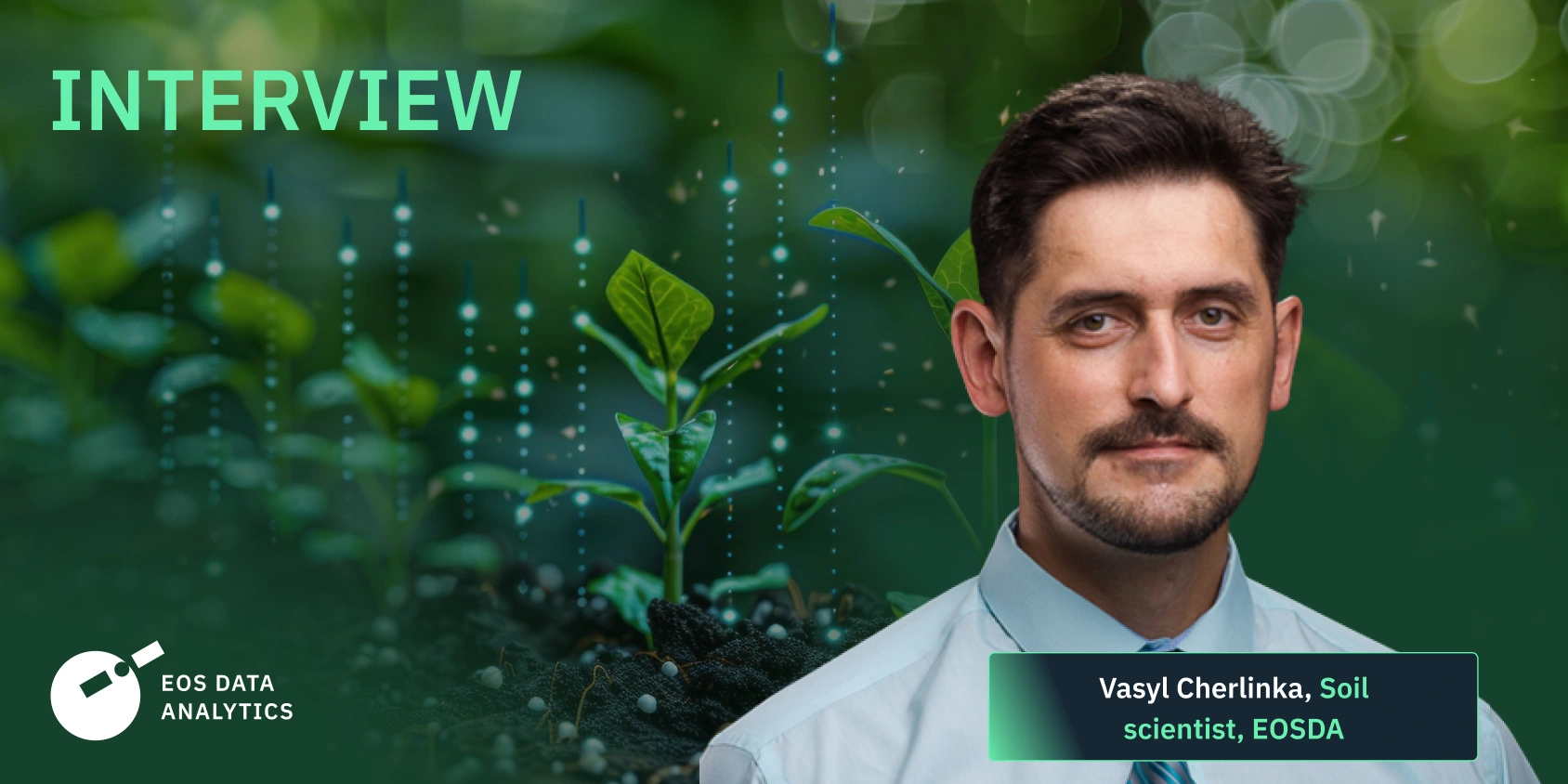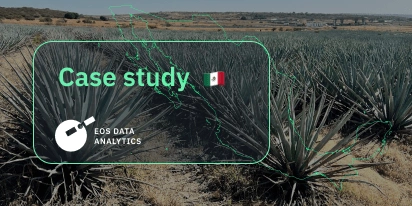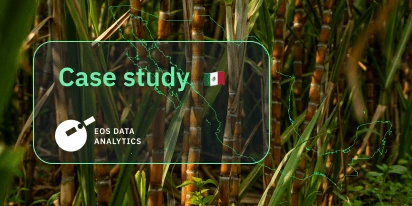
How GIS Will Reshape Agriculture In Upcoming Years
Geographic information systems (GIS) and the Internet create a combination that gathers data about the whole world. This combination changes all aspects of our lives, from the GPS in our phones that help us navigate home to the technology that assists farmers in precisely monitoring crop health. Agriculture is one of the industries that the development of GIS has already impacted, and this impact will only grow in time.
In order to find out more about how GIS can benefit agriculture, we talked to Dr. Vasyl Cherlinka, a member of the vibrant Science unit at EOS Data Analytics (EOSDA), a global AI-powered satellite imagery analytics provider. Dr. Cherlinka has 30 years of experience in soil science and is an informed specialist who closely follows the newest agritech trends. He uncovered some emerging tendencies on the edge between GIS and agriculture. Here is what you should look out for in the coming years.
What Key Trends Do You See Shaping The Future Of The Geospatial Industry?
The first ones I would undoubtedly name are AI and ML. Artificial intelligence and machine learning are revolutionizing the geospatial industry. AI’s integration into GIS enables the processing of vast data sets, uncovering trends that even expert analysts might miss. Notably, AI’s data handling and image recognition advancements have enhanced spatial analysis and visualization, proving invaluable in agriculture and soil science. This evolution has given rise to GeoAI, which merges AI with geospatial data and technology. GeoAI’s ability to extract, classify, and detect information from diverse sources significantly enhances our capacity to tackle complex spatial challenges, navigating a new era for GIS specialists.
Cloud computing is indispensable in geospatial work due to the enormous volume of high-resolution and historical data. Increased twice resolution quadruples the image size, and processing this data further multiplies storage needs. Cloud storage, such as AWS, which is used by EOSDA’s science team, provides the necessary scalability and computing power. This ensures efficient product performance for all users and supports vast client bases without space constraints. Moreover, cloud platforms offer cost-effective, on-demand computing, charging per request rather than continuous equipment rental. Looking ahead, adding AI to optimize data processing models to elevate cloud computing will enhance efficiency, reduce costs, and minimize environmental impact.
Automation of geospatial data gathering is rapidly advancing with remote sensing technologies like satellites, drones, and UAVs. Satellites provide global data acquisition with increasing resolution that, in turn, increases the quality of analytics. However, issues like data collection frequency and cloud cover persist. UAVs fill these gaps, offering targeted data collection, which AI will soon manage within automated field management systems (AFMS). These systems will integrate data from satellites, drones, and field sensors, creating a comprehensive view of plant and soil health. Additionally, drones will evolve to perform tasks like applying treatments, ultimately enabling a fully automated crop cultivation cycle through coordinated drone and satellite interactions.
Another prominent trend is the rise of 3D geospatial modeling and digital twins. Digital twins simulate locations or structures, enabling scenario testing and behavior prediction. 3D data is sourced from CAD systems for manufactured objects or through geodetic surveying and remote sensing technologies like LiDAR. Despite resource demands, rendering these models is cost-effective due to simplified three-dimensional representation.
Digital twins are now highly accurate, with significant applications in fields like geology and agronomy. Digital elevation models (DEMs), one type of digital twin, are crucial for equipment planning and modeling. Combining digital twins with AI offers new possibilities, such as creating 3D soil landscapes and voxel maps of soil characteristics. This technology will enable comprehensive agricultural production control and precise growth adjustments for each plant.
What Are The Practical Applications And Prospects Of Using GIS In Agriculture?
Location specification is one of them. It is crucial for agriculture, enabling precise activities like irrigating water-stressed areas or treating specific plants. In my recent article, “Cartographic Technique for Determining Areas of Soil Contamination by Heavy Metals,” my colleague and I explored using GIS to predict soil contamination impacts . By identifying source spots and using soil samples, we mapped contamination accurately. While remote sensing cannot quantify pollution, it effectively detects plant-toxic substances. Our cartographic models highlight pollutant concentrations and natural barriers, enhancing soil monitoring. This approach ensures accurate pollution control points, vital for monitoring programs, even when contamination isn’t visible.
Remote sensing is another application of GIS in agriculture. It involves obtaining information about objects, places, or phenomena from a distance, typically via aircraft or satellites. Technologies like satellite remote sensing, aerial photography, LiDAR, and SAR detect and classify objects on Earth’s surface, atmosphere, and water bodies. Satellite remote sensing reads multispectral or hyperspectral data, distinguishing features such as healthy vegetation reflecting infrared waves. Aerial photography, using aircraft and drones, is ideal for small fields and cloudy weather. LiDAR uses laser scanning to create 3D models of geographic features, mapping agricultural land, vegetation, and soil. SAR satellites emit radio waves, capturing high-resolution images day and night in any weather.
As a result of using the technologies mentioned above, precision agriculture leverages GIS to combine location data and remote sensing, enhancing agricultural efficiency. This method targets specific field areas for inputs or irrigation, preventing resource wastage in the spots that do not need them. In precision irrigation, my colleagues’ article, “Validation of Precipitation Obtained from GPM and H-SAF Satellite Data with Relation to Ukrainian Ground Weather Stations’ Data,” demonstrated that satellite data is a reliable source for determining precipitation levels . This finding confirms that GIS-based remote sensing is a dependable foundation for precision agriculture practices and informed decision-making.
Innovative solutions are revolutionizing agriculture, leveraging the expertise of data scientists, GIS specialists, and researchers. For instance, in EOSDA, we use advanced geospatial data and remote sensing to tackle agricultural challenges. Our achievements include precise field boundary detection, crop moisture and productivity modeling, soil indicator mapping, and powerful satellite analytics. We also create VRA maps, model soil organic carbon (both static and dynamic with RothC), and analyze soil water erosion. Furthermore, advanced image resolution technologies and optical recognition are enhancing the accuracy and efficiency of agricultural practices, driving significant improvements in resource management and productivity.
Can GIS Help Predict the Future in Agriculture?
This is an interesting question, and the answer to it is yes. A key GIS research focus is addressing the challenge of maximizing crop yield with limited soil resources. Precision agriculture, soil degradation modeling, and agro-landscape evolution prediction are vital areas. Yield estimation models are particularly in demand, helping agribusinesses predict crops and refine strategies. GIS specialists play an active role in this evolving field. Notable studies include “The Estimation of Crop Land Productivity Based on Satellite and Biophysical Modeled Data,” which develops a new productivity model, and “Enhancing WOFOST Crop Model with Unscented Kalman Filter Assimilation of Leaf Area Index,” which focuses on early yield prediction . These works emphasize the crucial role of GIS in agriculture.
GIS professionals play a crucial role in disease risk assessment for crops, combining location data with data science models. When unknown plant diseases emerge, GIS experts analyze vegetation indices dynamics alongside temperature, humidity, and soil nutrient data from remote sensing. Relief indicators are also assessed to identify natural and human-related factors influencing disease development. GIS specialists, often skilled in model building, contribute at every stage of data collection, processing, analysis, and model creation. These cartographic models produce risk zone maps, enhancing understanding of disease patterns, seasonal variations, and spatial factors, empowering agribusinesses to mitigate risks and optimize crop management strategies.
GIS specialists play an essential role in bridging spatial and terrestrial data with mathematical models, facilitating model creation, testing, and verification. They analyze diverse data sets to extract predictors and contribute to remote moisture analytics, which is crucial for determining irrigation frequency and efficiency. Additionally, GIS professionals are instrumental in crop type classification using remote sensing and machine learning algorithms. This trend enables agroholdings to monitor fields efficiently, saving time and resources previously spent on individual visits. By utilizing GIS expertise, agribusinesses optimize irrigation practices and enhance field management strategies, ultimately improving agricultural productivity and sustainability. That also leads to predictions in crop yields.
Predicting the future is also needed when addressing climate change. This is a key focus for the GIS community and EOSDA. GIS scientists have led efforts to model climate dynamics and human impact. Models like CANDY, CENTURY, and others accurately track carbon flows based on local conditions. EOSDA enhances the RothC model to predict carbon balance shifts under various management types, aiding CO2 sequestration efforts. Notably, the Global Soil Organic Carbon Sequestration Potential Map (GSOCseq), supported by the Global Soil Partnership and FAO, helps manage global carbon levels . The GIS community’s role extends across sectors, including forestry, manufacturing, transport, and energy, to combat climate change comprehensively.
So, Will Satellite Analytics Play An Important Role In The Connection Of GIS And Agriculture?
Satellites play a crucial role in remote sensing, offering unmatched coverage on a large scale, surpassing the capabilities of aerial objects. This extensive coverage facilitates the acquisition of constant data streams, which are then meticulously analyzed and presented to clients. Consequently, satellite analytics provides the most accurate and comprehensive datasets for agricultural applications, which is crucial for precision agriculture’s success and demands accuracy.
The synthesis of available and generated data, along with their subsequent processing and analysis, combined with the integration of machine learning methods and GeoAI, yields remarkable results. With ongoing technological advancements, these methodologies are poised to achieve even greater sophistication and effectiveness. Notably, the rapid evolution of GIS since the late 1980s, with accelerated progress driven by the recent advancements in AI, emphasizes the transformative potential of satellite analytics.
In this context, satellite analytics emerges as the future of GIS, agriculture, and GeoAI integration, offering unparalleled opportunities for optimizing agricultural practices, enhancing efficiency, and driving sustainable outcomes. This trajectory highlights the essential role of satellite analytics in shaping the future landscape of agricultural innovation and sustainability.
How EOSDA Plans To Adapt And Thrive In This Evolving Landscape?
EOSDA actively engages with stakeholders and scientists worldwide, responding to market demands by intensively developing soil organic carbon modeling. Soil serves as a vital carbon sink, sequestering CO2 through plant photosynthesis. By promoting leading agricultural practices, we regulate greenhouse gas emissions, aiding climate change mitigation. Our commitment to climate action drives us to excel in satellite imagery analytics, supporting our clients in climate adaptation and resilience. We’re also developing soil mapping technologies, including saline and salinized soil mapping methodologies. Our team is advancing fertilizer rate calculations based on planned crop yields. These initiatives are in active development, reflecting our dedication to innovation and addressing agricultural challenges in a rapidly changing climate.
In a recent article, my colleagues and I investigated the war’s impact on Ukrainian soil, employing GIS modeling to craft a detailed 25-meter resolution soil map . Scientists are utilizing GIS tools to address various war-related challenges, including monitoring traumatized soil, assessing battle impacts on ecosystems, and evaluating reclamation potential for restoration projects. Efforts also extend to phytoremediation prospects for heavy metal pollution and post-war irrigation system restoration.
Furthermore, GIS aids in demining through remote sensing technologies, contributing to post-conflict recovery efforts. These diverse GIS applications drive agricultural development and reshape the industry landscape. They emphasize the growing reliance on remote sensing and geospatial data to confront emerging challenges. As GIS integration continues to advance, it will play an increasingly vital role in addressing complex issues arising from conflicts and environmental disturbances, facilitating sustainable solutions, and restoring ecosystems and agricultural productivity in affected regions.
For GIS specialists, it’s imperative to adopt these advanced technologies to stay at the forefront of agricultural development. By utilizing GIS tools, professionals can contribute to optimizing agricultural practices, enhancing efficiency, and mitigating environmental impacts. Embracing the evolving landscape of GIS in agriculture empowers specialists to address emerging challenges, foster sustainable solutions, and shape the future of agricultural productivity and resilience.
About the author:
Kseniia Kunakh has over 6 years of writing experience, working in various domains, including business, educational, and media-directed texts. Kseniia’s previous experiences as a development manager in a Ukrainian eco-NGO and as a talent matcher in an IT company make her a perfect combination of someone who is passionate about eco-tech innovations and can communicate about them with ease.
Recent articles

Digital Tools Improve Soil Health And Yields In Mexico
EOSDA and ITTA supported a Guanajuato farm with contour-line planning, monitoring tools, and practical guidance to reduce soil erosion and improve yields in the long run.

Analyze 2025 & Plan Your Best Year Yet: LandViewer Christmas Offer
It’s the most wonderful time of the year! The Christmas holidays are here, and so is your chance to analyze 2025 and plan a prosperous 2026 with more affordable Pro plans in LandViewer.

EOSDA Models Climate Change Impact On Sugarcane Yields
EOSDA modeled future temperature, rainfall, and other climate impacts on Veracruz sugarcane. The results help growers plan long-term adaptation strategies, including timing, varieties, and irrigation.